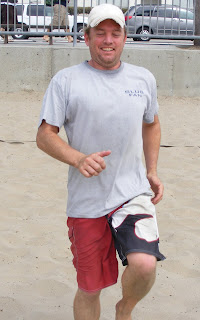Before performing these movements be sure to warm-up thoroughly using the exercises presented in the last two issues (http://fasttwitchfitness.blogspot.com/). Starting with high knees, perform each movement for the desired time (see below), rest, and then move onto the next movement. You will be performing a circuit of four movements. The goal is to perform these movements as quickly as you can for the allotted time. Maintain your speed as best you can throughout the allotted time.
If you have pre-existing injuries skip any movements that do not seem appropriate for you.
Recommended Work:Rest intervals
Beginners – 20:40 (20 seconds on, 40 seconds rest)
Intermediate – 30:30 (30 seconds on, 30 seconds rest)
And Intermediates do – 30:30 (30 seconds on, 30 seconds rest)
By the way, it helps if you can be in a good mood while doing these exercises, like this cheery guy!
SKATERS: This is a great exercise for the glutes. Stand tall with feet at least shoulder width apart. Shift weight to left leg while bending your left knee. Swing arms to the left as you bring your right leg behind your left. Quickly switch sides by pushing off from your left leg and hopping towards your right. Land on your right leg and allow your left leg to swing behind and your arms to swing naturally to the right. Repeat back and forth for the allotted time: Beginners – 20:40 (20 seconds on, 40 seconds rest)
Intermediate – 30:30 (30 seconds on, 30 seconds rest)
IN AND OUTS: Stand tall with feet wider than shoulder width apart. Step your right foot in and then step your left foot in. Next step your right foot out wide and follow it by stepping the left foot wide. Repeat for the desired time. If your dance moves are more Elaine Benes than Britney Spears, it may help to say “in-in-out-out” while performing this movement. Concentrate on moving your feet as fast as possible. Beginners, do this move for – 20:40 (20 seconds on, 40 seconds rest) and Intermediates, do – 30:30 (30 seconds on, 30 seconds rest)
DIAMOND JUMPS: Draw four small Xs, 11/2 to 2 feet apart from each other in a shape of diamond. Start by standing at the top of the diamond. Keeping ankles together, jump clockwise in a diamond pattern. Land on the balls of your feet and use a double arm swing to stabilize your body. Switch directions at the halfway point (10 seconds for beginners, 15 seconds for intermediate) and jump counterclockwise for the remainder of the time. Remember, the point of this is to increase speed, so concentrate on getting as many hops as you can in the allotted time (Beginners – 20:40 (20 seconds on, 40 seconds rest) Intermediate – 30:30 (30 seconds on, 30 seconds rest)
He Sticks the Landing! Judges Score: a Perfect 10!
Whew! Rest 1-2 minutes and then repeat the circuit. Yes, repeat it!
If you perform these exercises regularly (2-3 times a week), you will notice your speed increasing and it will become easier to go for longer durations for each exercise. These simple and effective exercises will prepare your muscles for the high demands of the beach game and your opponents won’t know what hit them!
See you on the beach!
Eric Hand, MA , CMT
Clinical Exercise Physiologist
Fast Twitch Fitness























